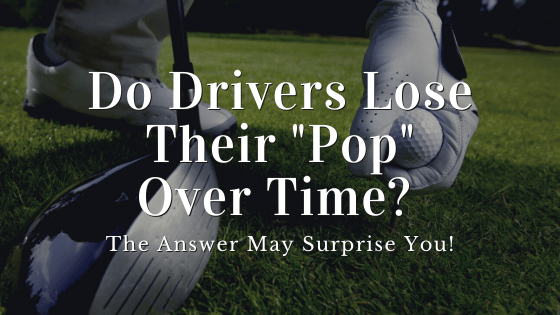When you buy a driver you want it to last, right? Yet still one of the biggest concerns for so many golfers is if their new driver will stand the test of time.

So many people get a new driver, feel like they are getting great distances and consistency then all of sudden it all goes downhill…
You feel like you aren’t hitting it as far, as straight, or as consistently and start to think “is my new, $450 driver wearing out ALREADY?!”
Let’s dive into if this is the case.
There are typically two things that people attribute to the loss of performance in a new driver.
- Loss of “pop” in the clubface: This is just another word for the trampoline effect on the face of the club and officially known as the COR (more on that here)
- The shaft stiffing or getting more flexible as a result of overuse. (frankly, the stiffing concept doesn’t really make sense, but we have heard it theorized so we have to address it).
Some of the reasoning for these thoughts is because of golfers observing or hearing of tour pros shattering or cracking their club faces or snapping shafts when they are swinging.
Now, this does happen but we as average joe golfers need to realize that there a significant difference in the way that we play compared to the pros.
They are out at the range every day hitting hundreds of balls and they play golf multiple times a week out on the course, so their clubs are getting a lot more wear and tear.
Additionally, they also have significantly higher swing speeds between 110 – 125 mph on average while the regular everyday golfer is between 90 and 105 mp.
So, with each impact on the ball, they are expecting a lot more out of their clubs.
Lastly, they make consistent contact with the sweet spot while, as much as I hate to say it, we average golfers just don’t.
Ultimately we aren’t using our clubs as much, aren’t hitting as fast and aren’t making as consistent of contact leading for us to have different amounts of wear and tear of our clubs.
In fact, we will most likely see physical wear and tear or damage to other parts of the club before we will see a decrease in the “pop” of the driver or a change in the shaft’s performance (especially a graphite one).
To give you a time expectancy, a consistent golfer (playing 40+ round a year and going to the range 1x per week) should be able to go at least 5 years before seeing any decrease in performance with almost any driver made in the last decade.
The standard time that a golfer goes until they replace their driver is 3-5 years so statistically, you will probably replace your driver before yours starts to show any decrease in performance.
However, if you are worried that yours might be an exception a good way to test if your driver’s face is losing its spring effect is to take the flat edge of a credit card and put it against the face of your driver.
If you are able to rock the card/ there is space under each corner, then your driver is still performing just as well as when you bought it.
In regards to the shaft, there is no real way to test if it has gotten more or less flexible aside from comparing it to a brand new one or getting refit and comparing your results.
However, we can say with relative certainty that a change in the integrity of your shaft is most likely not the cause of decreased performance.
Now you may ask “If my driver’s performance isn’t worsening then why do I feel like I am playing worse than when I first bought it!?”
Well, I hate to give you such a simple answer but you have become a victim of your own self-delusion (otherwise known as the placebo effect).
What this means is that you were playing better because you thought you would and over time that little voice in your head that goes “what if I slice it” as you walk up to the tee has gotten louder and taken back more and more control making you perform worse.
The good part is that this happens to everyone and is even something the pros have to think about.
Our mindset about how we will perform has a big impact on how we actually do and you have now officially experienced what it’s like.
In fact, there have been some recent studies that may suggest that drivers hit it FARTHER over time as a result of the face becoming more flexible…
Overall, next time you are out on the course thinking that your brand new driver isn’t performing as it used to, just remember that is most likely the voices in your head wearing you down, not the driver in your bag wearing out.

